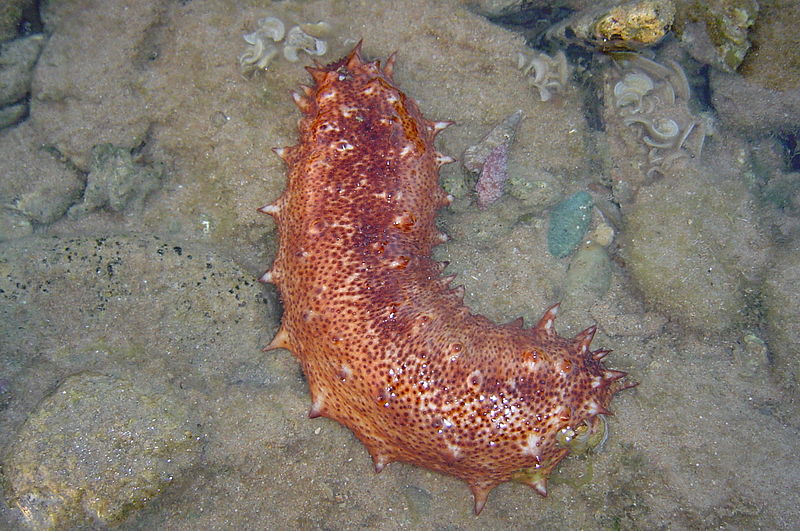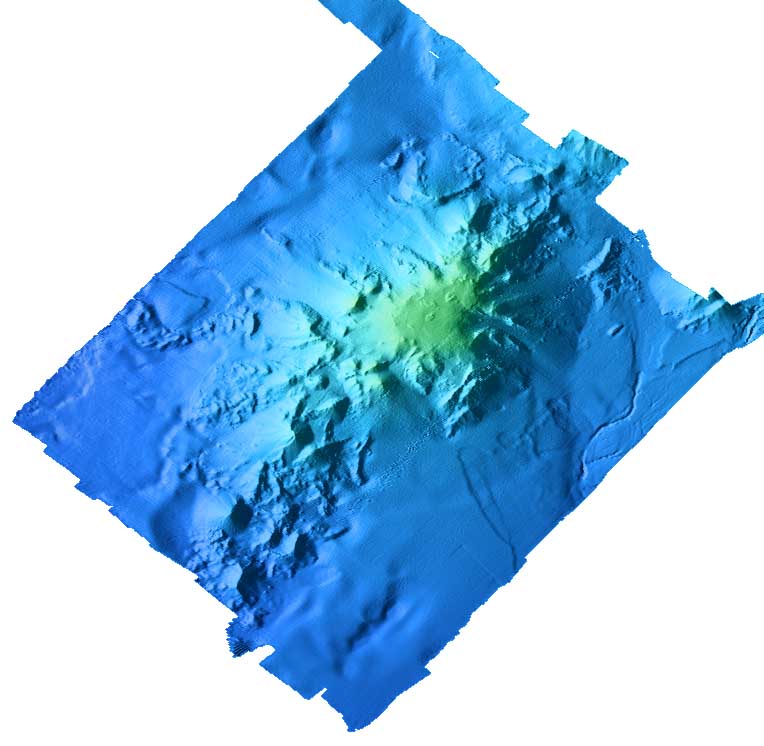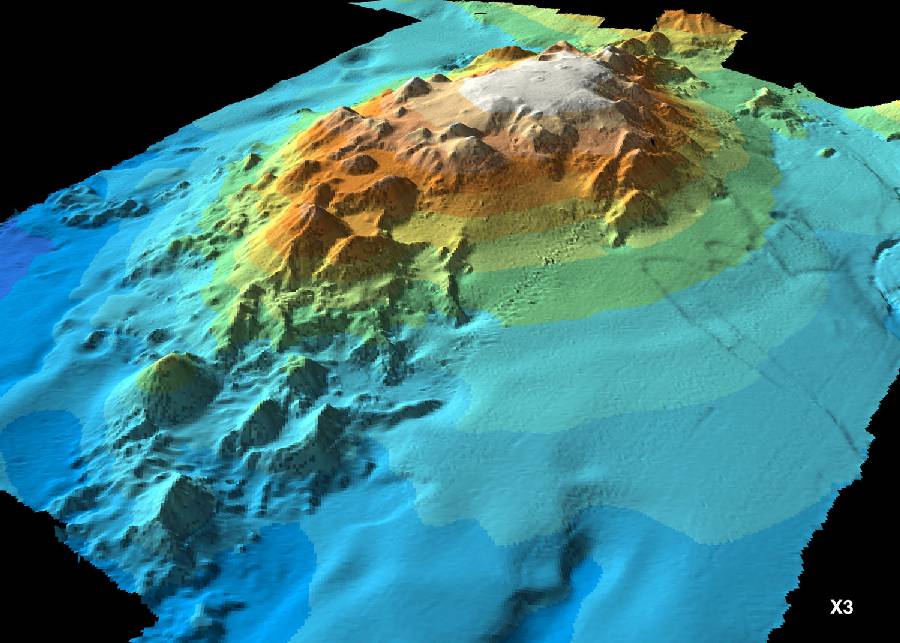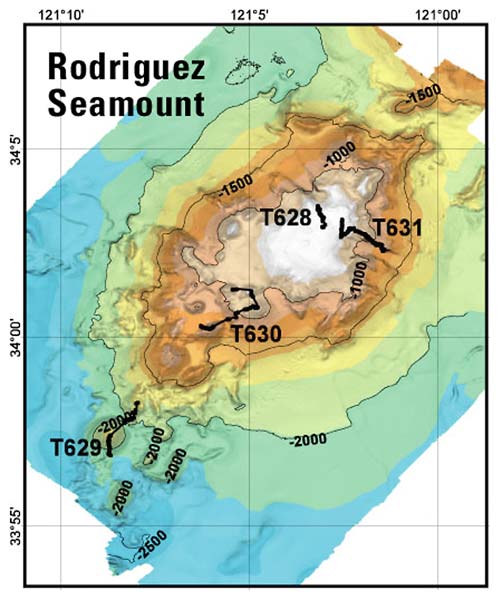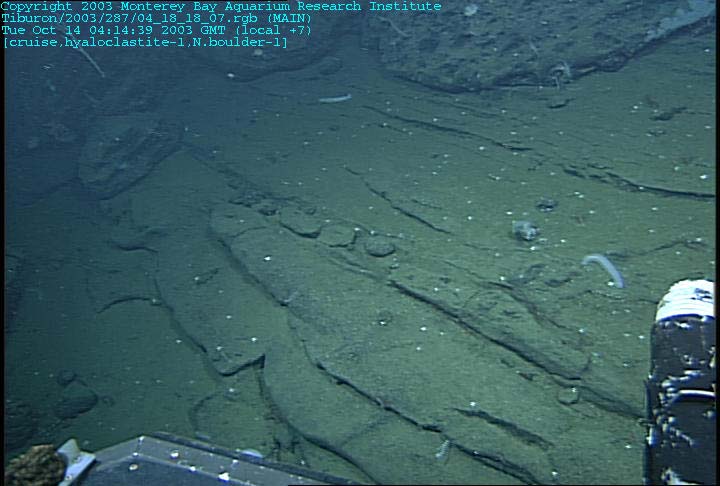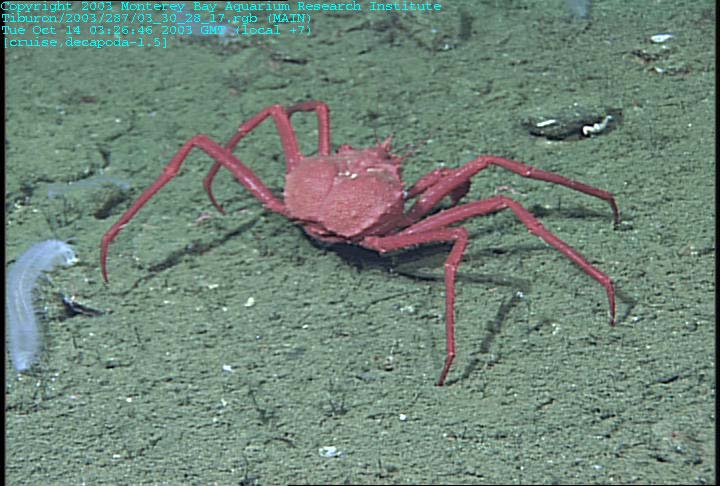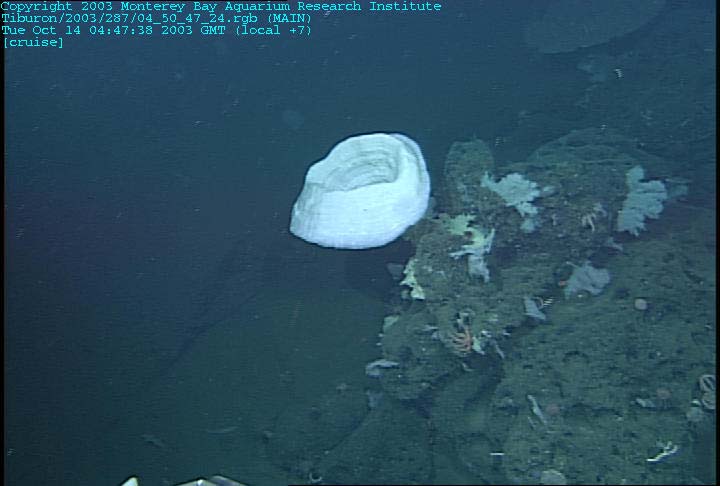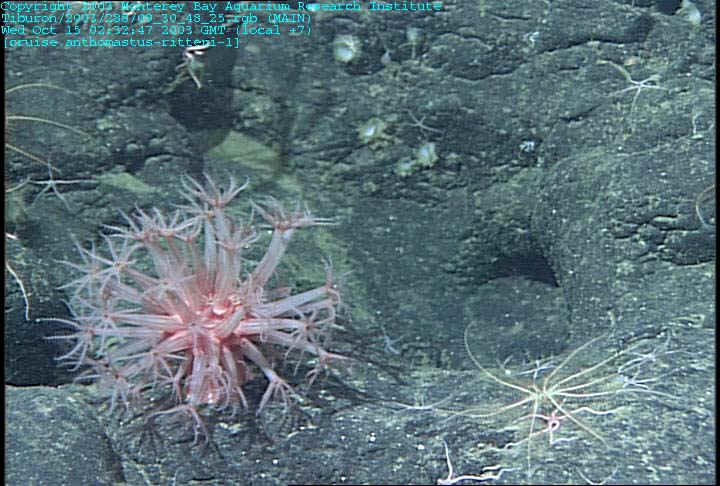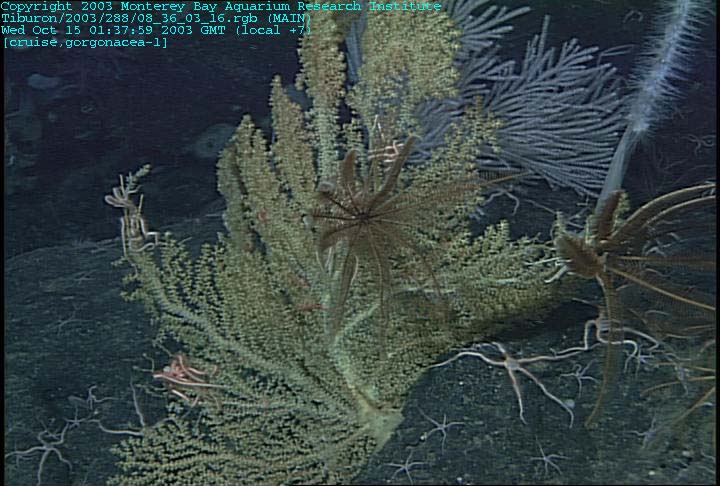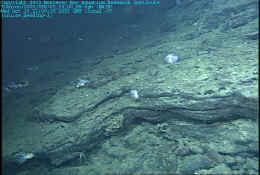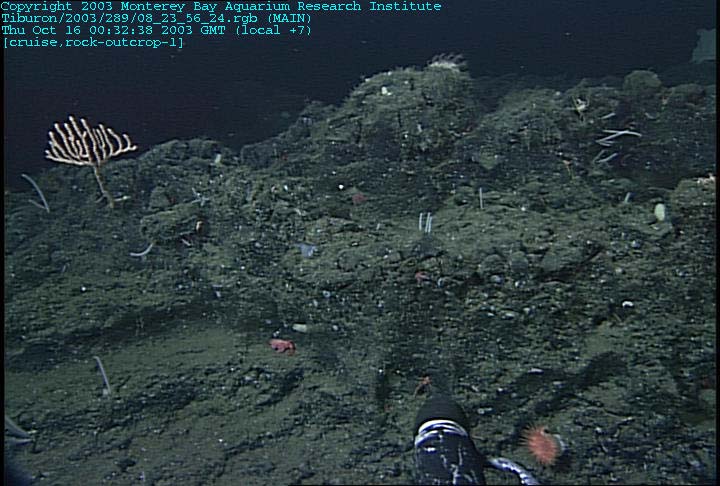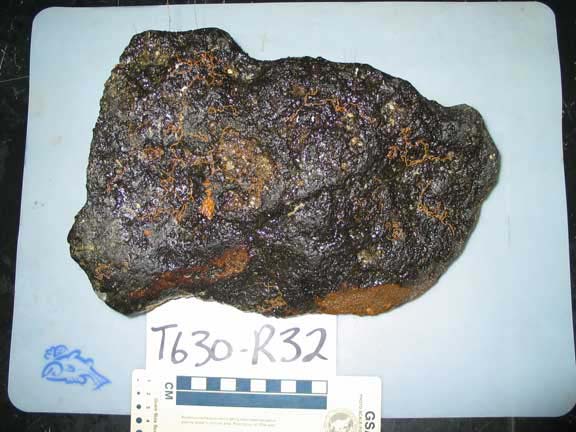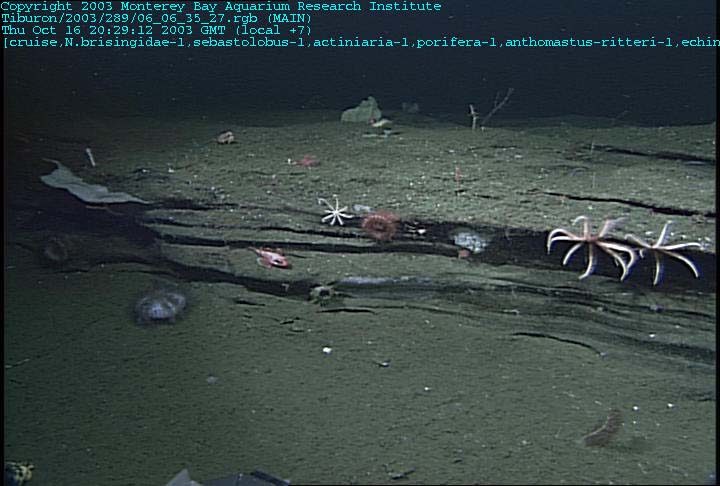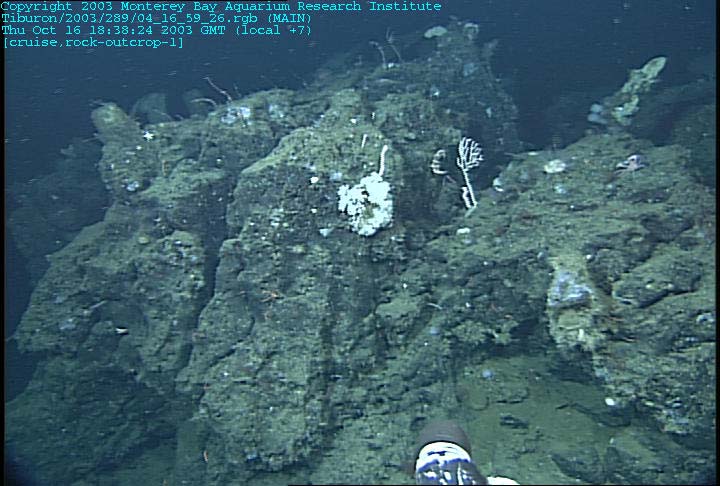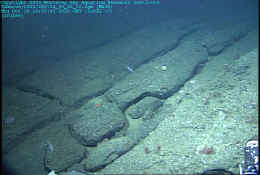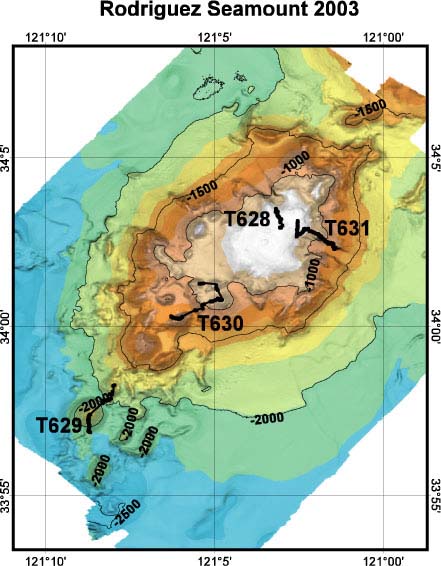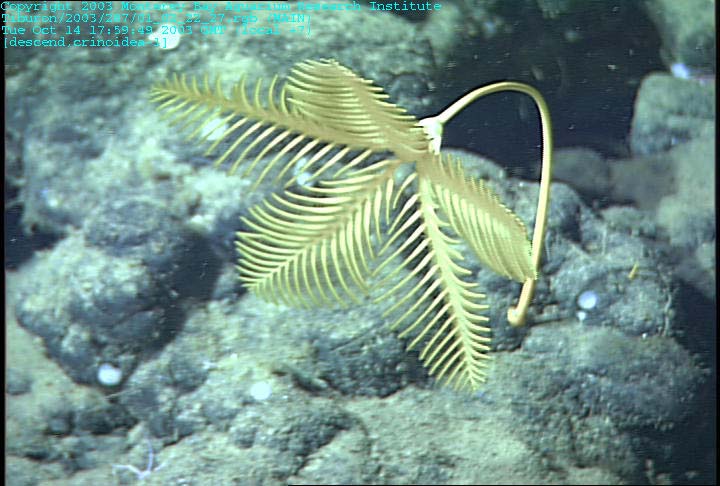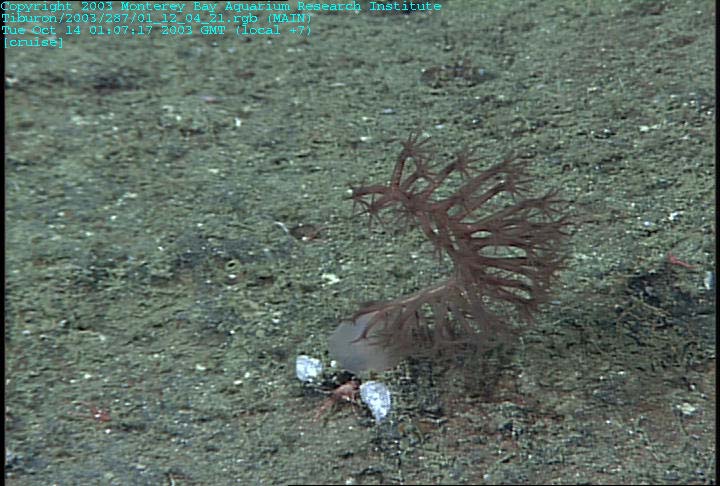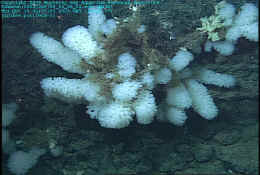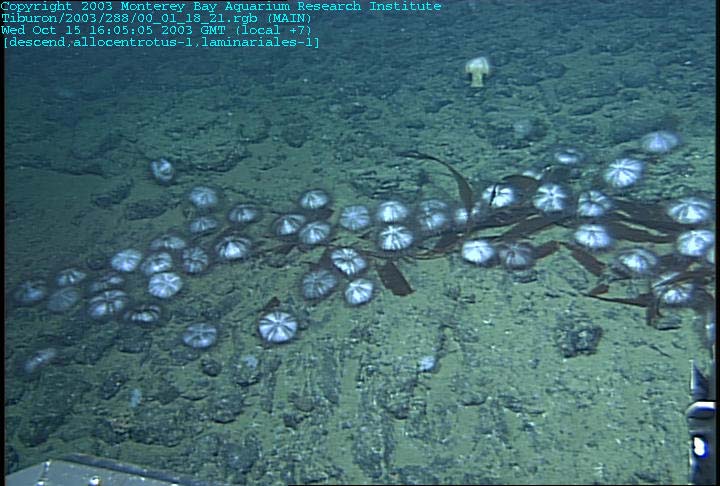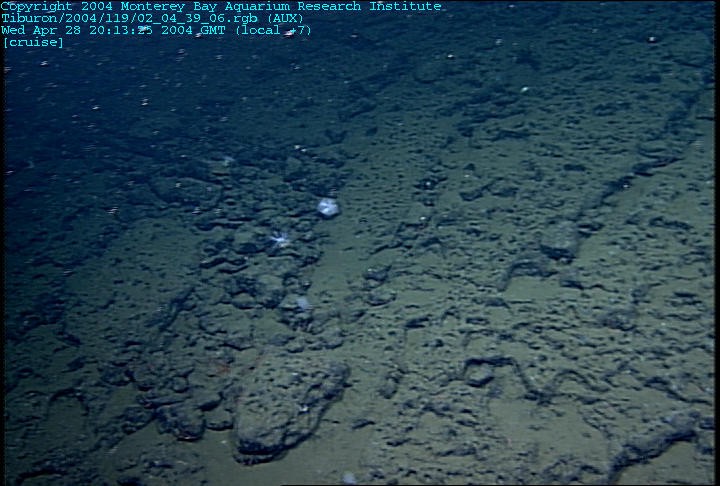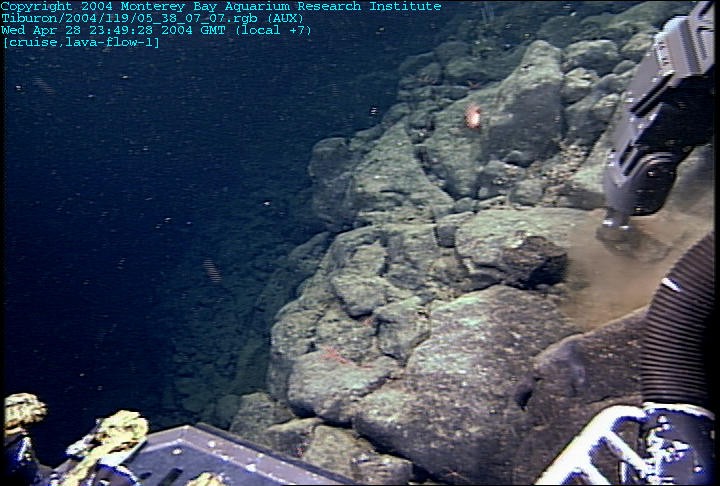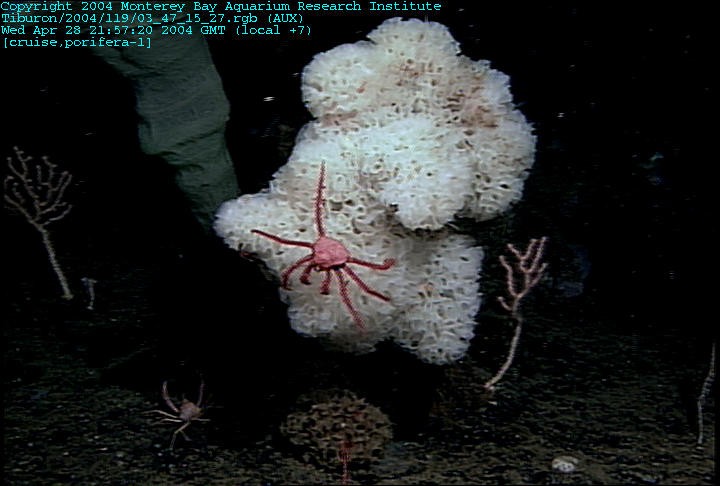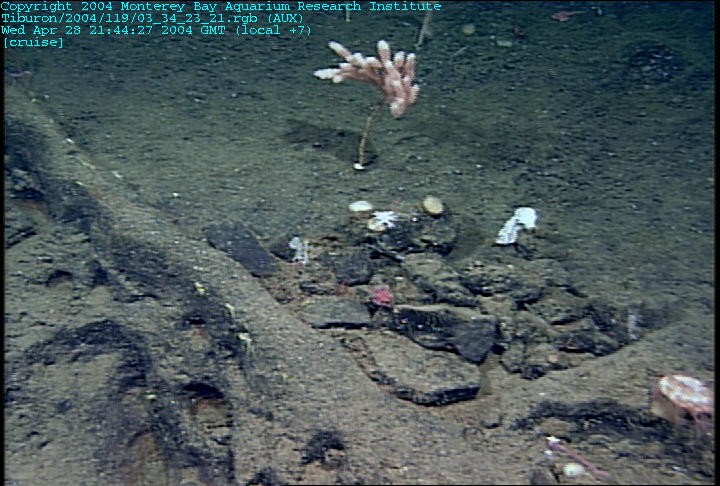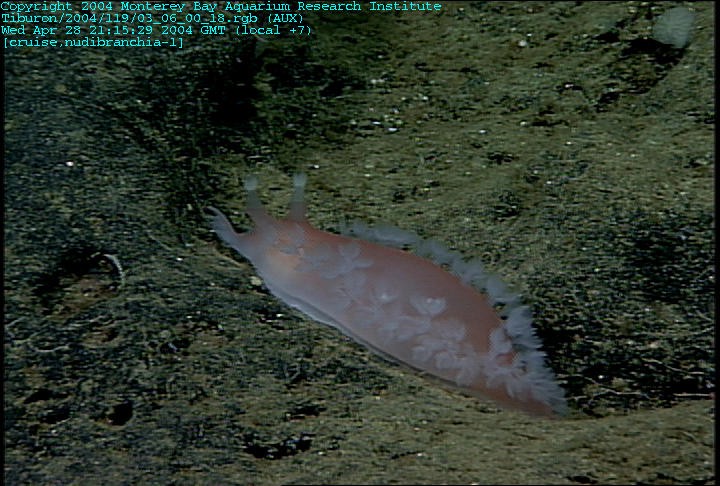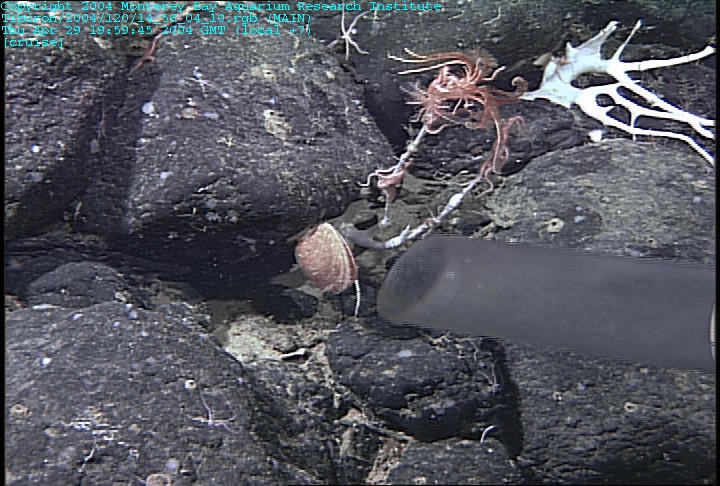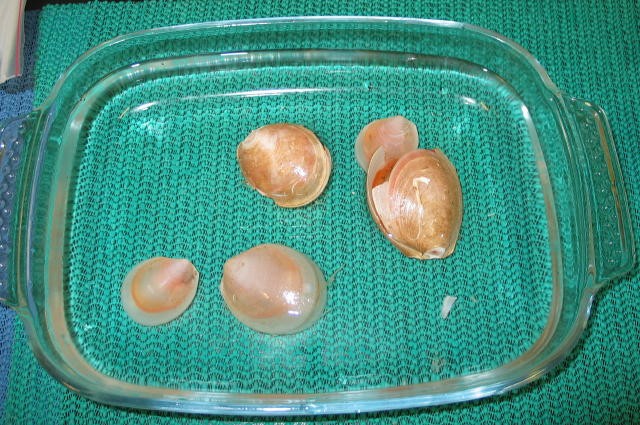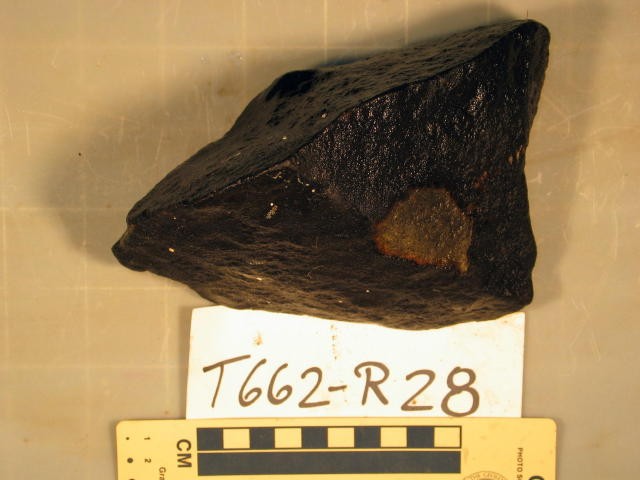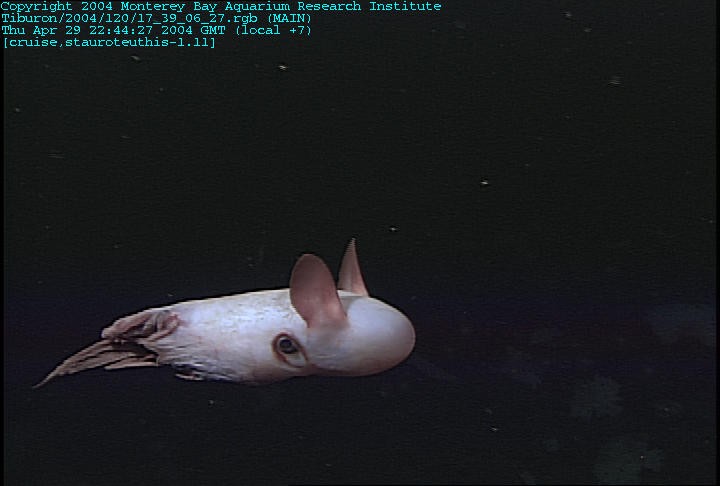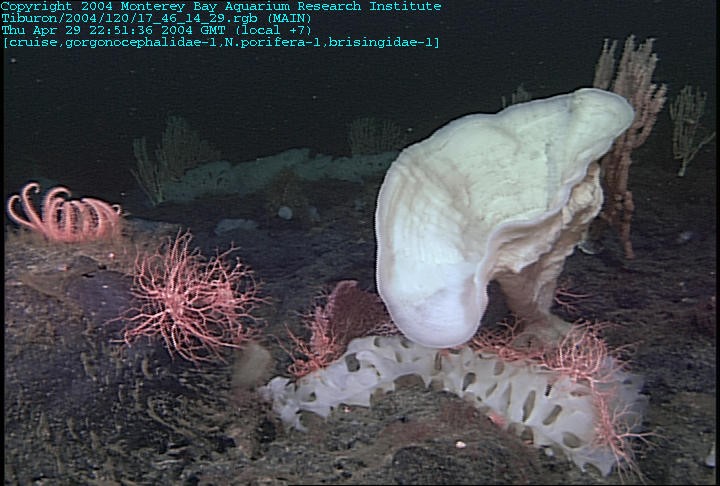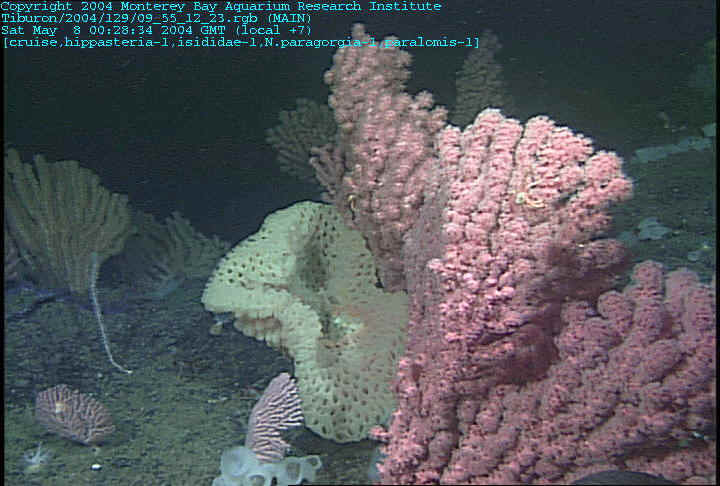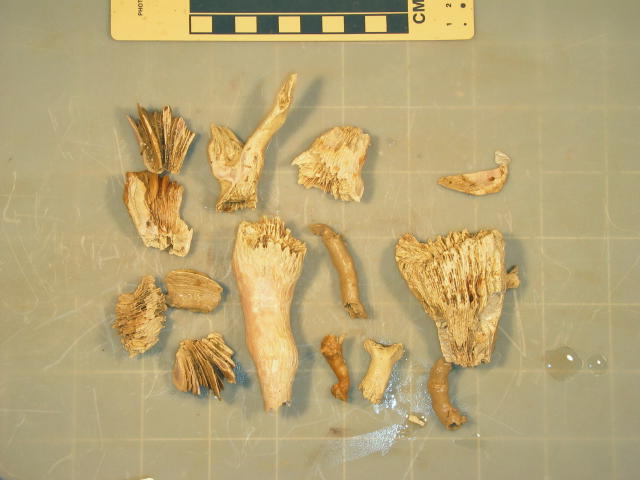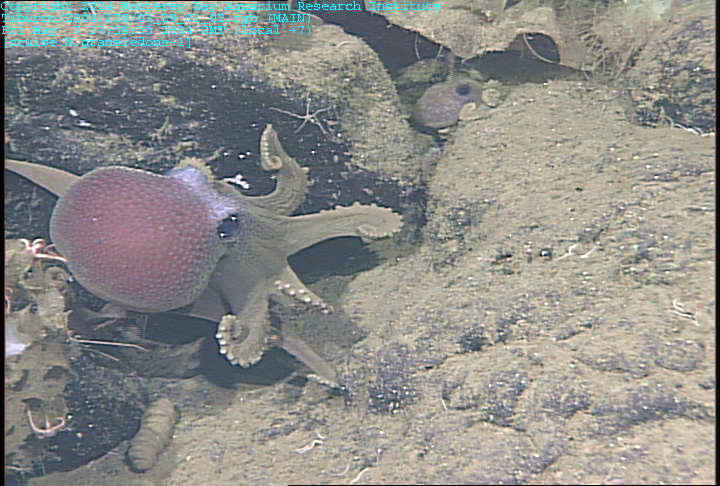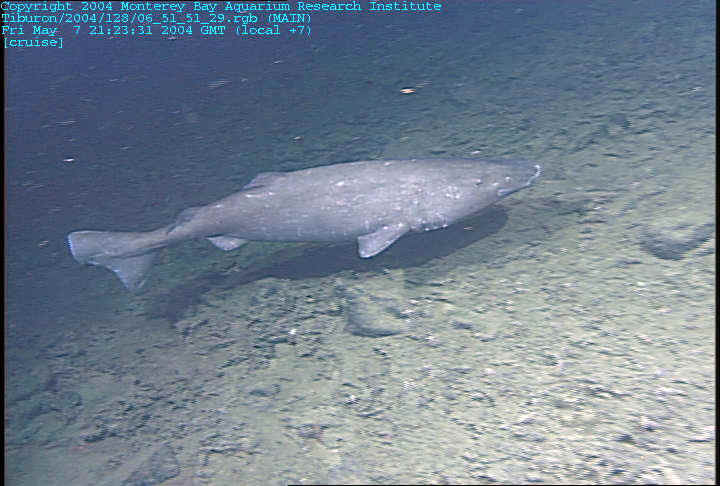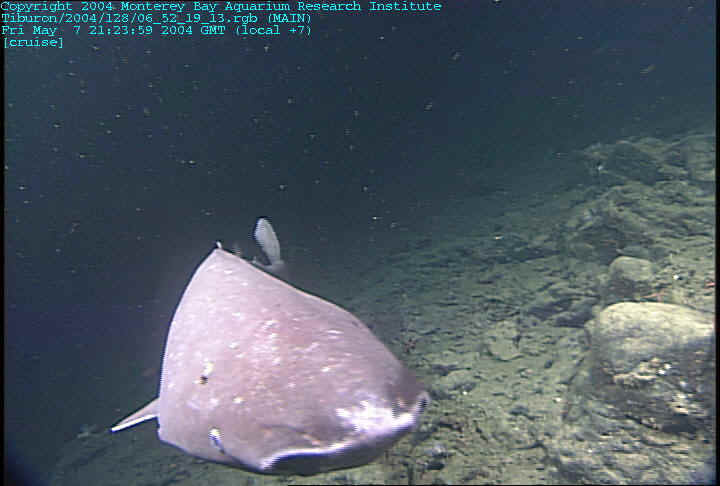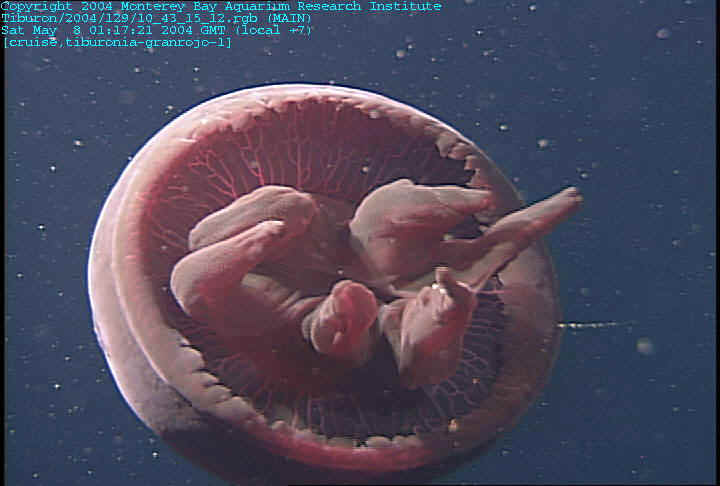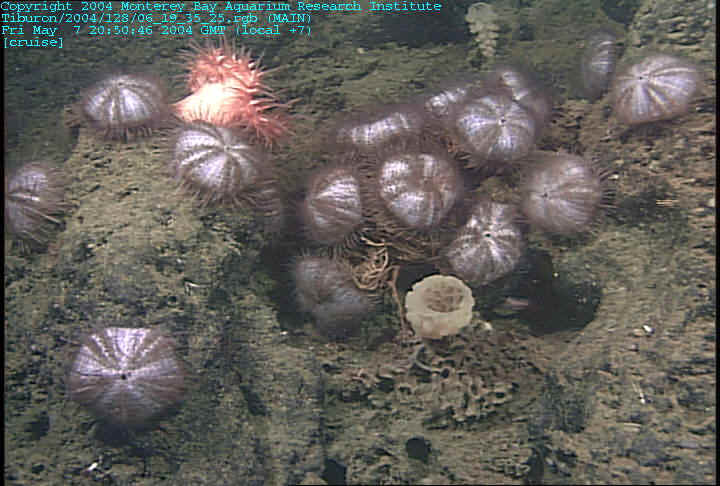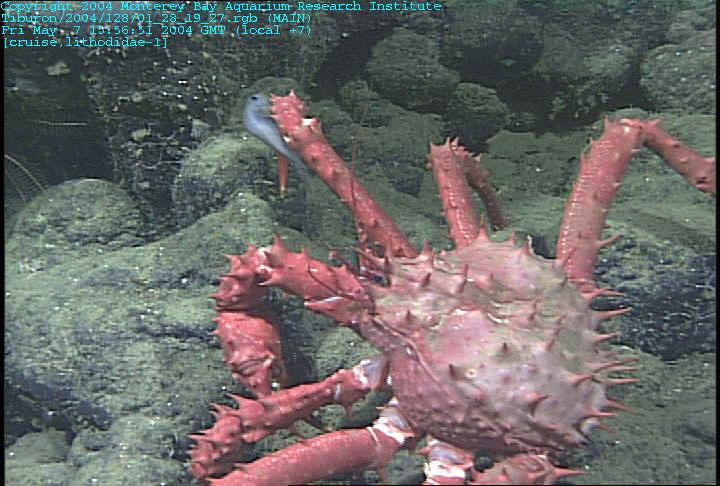 | Rodriguez Seamount |
http://en.wikipedia.org/wiki/Sea_cucumber |
|
|
http://en.wikipedia.org/wiki/Rodriguez_Seamount |
Bedded volcanic sandstone at 650m depth. Could this once have been a shoreline? A black sand beach? - text-http://www.mbari.org/expeditions/Seamounts03/October13.htm |
Large red crab, possibly Neolithodes; a sea cucumber (Pannychia) is on the left |
Large white trumpet sponge on an outcrop that is also home to small coral fans |
The rocks on this seamount are heavily coated in manganese-oxide crusts precipitated from seawater over the years. Here a heavily encrusted lava flow provides a substrate for a pink mushroom coral (Anthomastus |
A gold coral sea fan is host to numerous other animals seeking a higher perch in the water column: feather stars (aka crinoids) and brittle stars. Behind the gold coral is a gorgonian and a stalked sponge with glass spicules. We found a dead sponge of this type that had attached to it large white eggs we think might be from a squid |
Thick beds of volcaniclastic material, possibly deposited by an explosive eruption or fragmentation when hot lava contacted cold seawater |
At the summit of a cone on the flank of Rodriquez Seamount, we found this outcrop that may be the vent that supplied the fragmental material draping the slope of the cone |
Photo of a volcaniclastic rock (volcanic sandstone) from the slope of a small cone on the flank of Rodriguez Seamount |
located on the northeast side of the seamount and addressed several questions about the formation of the seamount. We started in an amphitheater that looks like a large landslide scar that dissects two volcanic cones. The interpretation, based entirely on morphology, turned out to be correct and the fault cutting the deeper cone exposed a stack of thick lava flows. The thickest flow was about 50 meters thick and several others were more than 20 meters thick. Such thick flows are consistent with low-temperature viscous (pasty) lava. We recovered samples from the interiors of these flows, which are usually suitable for radiometric dating. The shallower cone was also dissected by the fault bounding the landslide, but the cross-section through the flank of the cone consisted of a thick series of volcaniclastic layers, ranging from breccia to sandstone. The shallower cone apparently erupted explosively throughout its history.Cross section of bedded volcanic sandstone that shows evidence of deposition by currents.-text- http://www.mbari.org/expeditions/Seamounts03/October16.htm |
Thick lava flow at 720 meters water depth, that may have flowed across an ancient beach when the volcano was at sea level |
Landscape of volcaniclastic sandstones showing separation of beds of movement down slope |
|
Yellow stalked crinoid |
A maroon sea pen, which prefers rocky substrates such as this volcaniclastic pavement |
Cluster of glass sponges attached to lava outcrop |
Large pale purple pancake urchins gathered on drift kelp |
Pitted, eroded pavement, as we typically observed for volcaniclastic material |
Basalt sample being collected from the face of a lava flow |
Crab clinging to a glass sponge with small gorgonians nearby and a trumpet-shaped sponge in the background |
These ~1/4 meter high ridges in the volcaniclastic rock are slightly more resistant to erosion than the surrounding rock. Circulation of fluids through fractures altered the rock, possibly soon after it was deposited. The angular pattern of ridges has collected basalt talus that slid down-slope. |
This lovely, ~10 centimeter-long nudibranch was one of a pair we saw. Nudibranch translates to "naked gills". The translucent frills along its back are the gills, which absorb oxygen and release carbon dioxide. |
This clam attaches to rocks like a brachiopod |
Seamount clams in a dish of seawater prior to being frozen for later study. These clams have an extremely thin, fragile, nearly transparent shell and a pink body. |
Angular basalt rock just collected from an outcrop of lava |
A Stauroteuthis octopus |
Brisingid and basket stars, white trumpet and frilled sponges, and a bamboo coral (in the background) are living attached to a lava flow |
|
The dive was more striking in terms of the biology since the first several cones had familiar assemblages of sponges, crinoids, anemones, urchins, and cucumbers, but a single cone in the middle of the dive had abundant large Paragorgia and bamboo corals similar to the summit of Davidson Seamount. |
Large solitary cup-corals sieved from sediments collected from the fossil-bearing deposit |
Rodriguez Seamount and green water rich with "marine snow" (particles of molts, mucus, fecal pellets, and bits of dead plankton drifting down from the sunlit surface waters, which provides food for the critters in the dark deep-sea where photosynthesis does not occur).A baby octopus (probably Graneledone spp.) hides under a rock, while a larger octopus (also Graneledone) glides around just outside. Whether the larger one was protecting or hunting or even aware of the smaller one, we will never know. |
a 6-8 feet long sleeper shark (Somniosus pacificus) |
The sleeper shark |
Tiburonia granrojo |
A kelp holdfast is a meal for the dinner-plate-sized purple pancake urchin, Tromikosoma. (An anemone and sponge are also in the photo.) The kelp must have drifted out from coastal waters. We lifted the holdfast and examined it for any rocks that it may have transported with it, but found only pebbles. We suspect that kelp holdfasts may be a source for the many continentally-derived cobbles we find on the seamounts. |
A crab (family Lithodidae) has a tiny snailfish (fam. Liparidae) cleaning its leg. |
from http://en.wikipedia.org/wiki/Rodriguez_Seamount
Rodriguez Seamount is a seamount and guyot located about 150 km (93 mi) off the coast of Central California. It is structurally similar to the nearby Guide, Pioneer, Gumdrop, and Davidson seamounts, all located roughly between 37.5� and 34.0� degrees of latitude. This group of seamounts is morphologically unique, and the mounts are very similar to one another.
The seamount structures run parallel to an ancient spreading center which has since been replaced in its role by the San Andreas Fault system.
Magnetic anomalies at Rodriguez indicate that it is located on a 19-million-year-old crustal surface.
Rocks recovered from Rodriguez Seamount are largely composed of alkaline basalt and Hawaiite. Ar-Ar dating techniques indicate that the volcano is between 10 and 12 million years of age.
Rodriguez Seamount rises about 1,675 m (5,495 ft) above the surrounding seafloor, to a minimum depth of 650 m (2,133 ft). Its calculated volume is greater than 205 km3 (49 cu mi); however this is likely an understatement because the survey did not include its lowermost slope.
The slope is composed mostly of layered volcanic rock, mostly coarse sandstone, with a few scattered large lava boulders. They were likely formed from fragments of volcanic glass formed in the steam explosions of lava touching down against water, similar to the process that is happening today on Kilauea. This would have built a black sand beach over time; however, following millions of years of alterations, most of the sand has since been converted into clay. Small hills, constructed of jagged lava flows, are thought to have resulted from subaerial ''a''a flows.
The northeast-trending ridges, which are common to the group that Rodriquez Seamount is in, are less distinct on Rodriguez than on the other seamounts in the group. In addition, the seamount is propagated by several large volcanic cones, the largest of which is 700 m (2,297 ft) tall and 2.2 km (1.4 mi) at the base, with a volume of about 2.6 km3 (1 cu mi). The lower flanks of the volcano have slumped and are covered in a thick layer of sediment, particularly the southwest flank. Another slump area to the west flank has blocky debris on it, suggesting that the base of the volcano has also started collapsing into itself.
Rodriguez Seamount once extended above sea level, resulting in a flat, sediment-covered summit that is coated with beach sands of ancient origin. This flat top earns it the distinction of being a guyot. These sands have been colonized by, among others, sea cucumbers.
An expedition in 2003 included Rodriguez Seamount as one of its destinations. Observations made during the expedition confirmed theories that the seamount had once been above sea level, and has since subsided about 750 m (2,461 ft) from its former height.
A sandstone structure discovered at 650 m (2,133 ft) depth seems to hint at a former sand beach and shoreline.
From http://www.mbari.org/data/mapping/SBBasin/rod_summit.htm
http://www.mbari.org/data/mapping/SBBasin/rodriguez.htm
Rodriguez is called a guyot because it has a distinctive flat top with a sharp break-in-slope at 700 m depth, suggesting wave planation at sea level after volcanic activity ceased.
Rodriguez Guyot (a flat-topped submarine mountain) is located about halfway up the continental rise, offshore Santa Barbara. It is structurally similar to Guide, Gumdrop, Pioneer, and Davidson Seamounts, all located farther north at the base of the continental slope about 150 km off the central California coast.
These submarine volcanoes are morphologically distinct from typical ocean island volcanoes and seamounts in having complex, elongated structures with a distinctive northeast to southwest orientation common to many other volcanic edifices near the continental margins of Southern and Baja California (Atwater and Severinghaus, 1989; Lonsdale, 1991). They are aligned parallel to, and perhaps on top of, abandoned mid-ocean spreading ridges. Magnetic anomalies outboard from Rodriguez are Chron 5E indicating it is located on 19 million year old ocean crust (Atwater and Severinghouse, 1989). Rocks recovered from Rodriguez Guyot are alkalic basalt and hawaiite (Davis et al., 1995; and submitted) and have been dated by Ar-Ar techniques that indicate that the volcano is 10 to 12 million years old (Davis et al., 1995; and submitted). These seamounts, including Rodriguez, are the product of intraplate oceanic volcanism unrelated to hot spots (Davis et al., submitted).
Rodriguez Guyot rises about 1,675 meters above the surrounding seafloor to a minimum water depth of 650 meters. Its calculated volume of 205 km3 is probably a minimum value because the survey did not cover the lowermost slopes (Davis et al., submitted). The NE fabric is less well-defined than for most of the other seamounts, and large volcanic cones are also present. The largest of the cones is 700 m tall and 2.2 km across at the base and has a volume of about 2.6 km3. The sediment drape on the lower flanks of the volcano has slumped, particularly on the southwest flank. Another slump on the west flank has a field of blocky debris at its base, suggesting that the volcanic basement also slumped.
